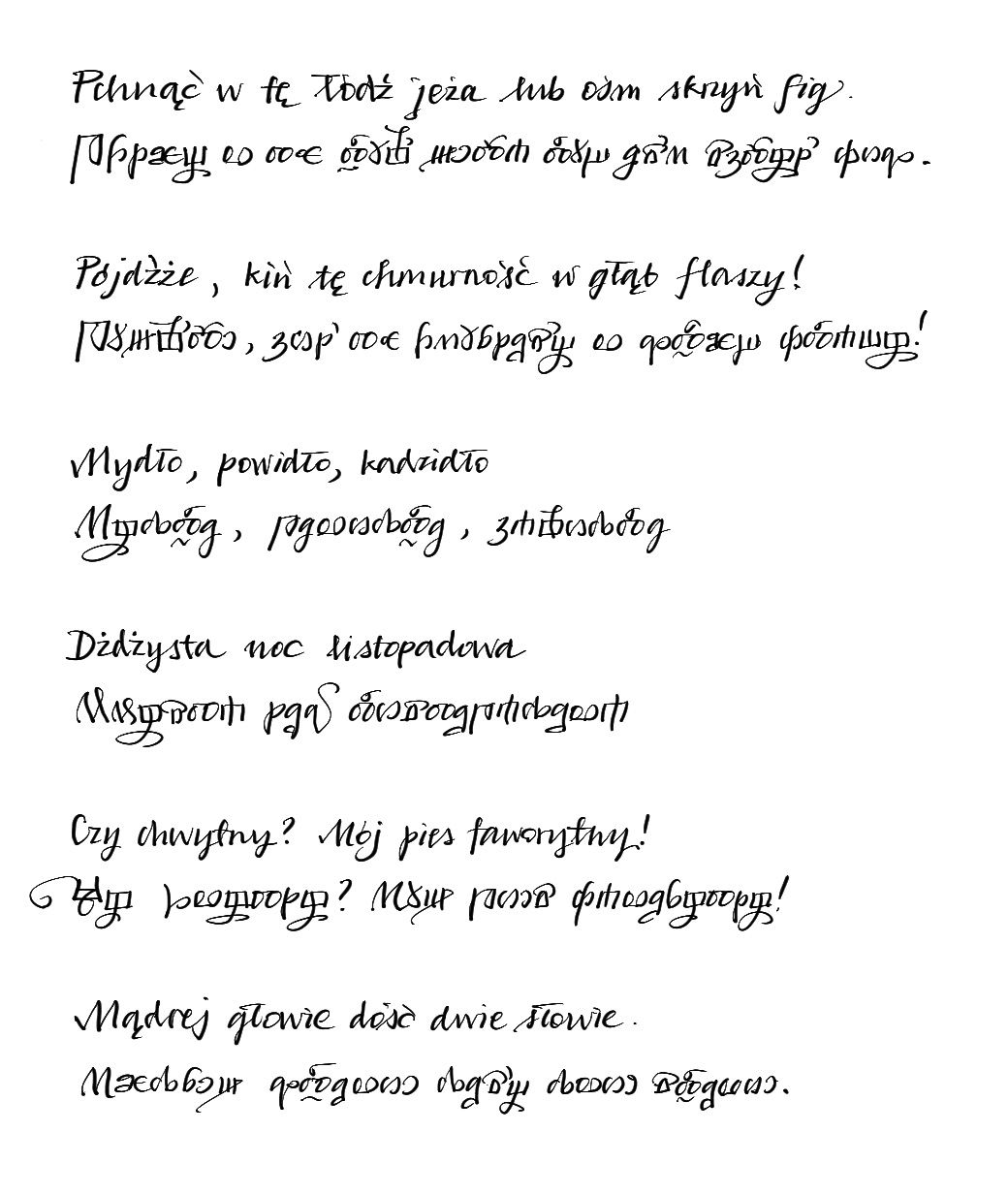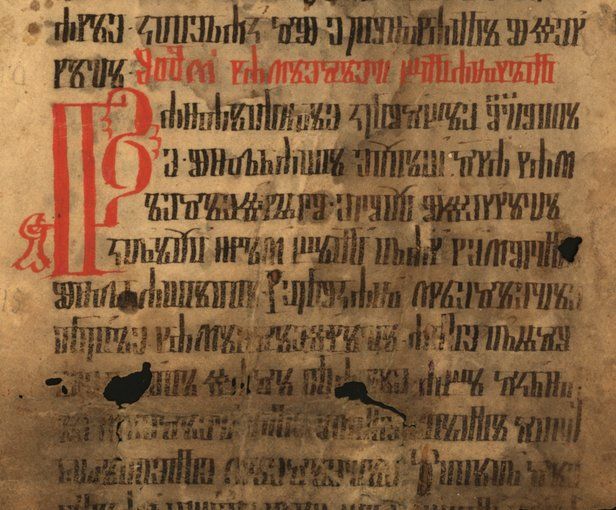In this post, I would like to present a little side project that I have been working on recently: a creative adaptation of medieval Glagolitsa to modern Polish language.
For those of you who never heard about it, glagolitic script (aka Glagolitsa) is an alphabet specifically designed for the phonetics of Slavic languages. It was created in the 9th century by Saint Cyril, a Greek monk (or at least that's what the story says). It was relatively popular for a while in some Slavic-speaking territories and countries, like the Bulgarian Empire, but was soon replaced by the Cyrillic script - an alphabet partly based on it, but simpler, and more similar to Greek. Since then, it continued to be used for liturgical purposes in some Christian traditions, slowly losing its reach and popularity. Glagolitsa hasn't been in active use for centuries now, and it hasn't been adopted by any modern Slavic language; which - I thought - is a shame, since it would be quite a good match. I therefore decided to give it a try, and see how it would go along with modern Polish.
Is my attempt going to be historically and linguistically orthodox? Probably not. Has anybody done that before? Possibly yes (though I haven't been able to find anything about it). Either way, it's not my primary goal to innovate, but rather to play around.
As this idea might sound a bit weird and obscure, and might also bear some connotation that I'd rather avoid, let me start with a few words of explanation that will hopefully make my intentions clearer.
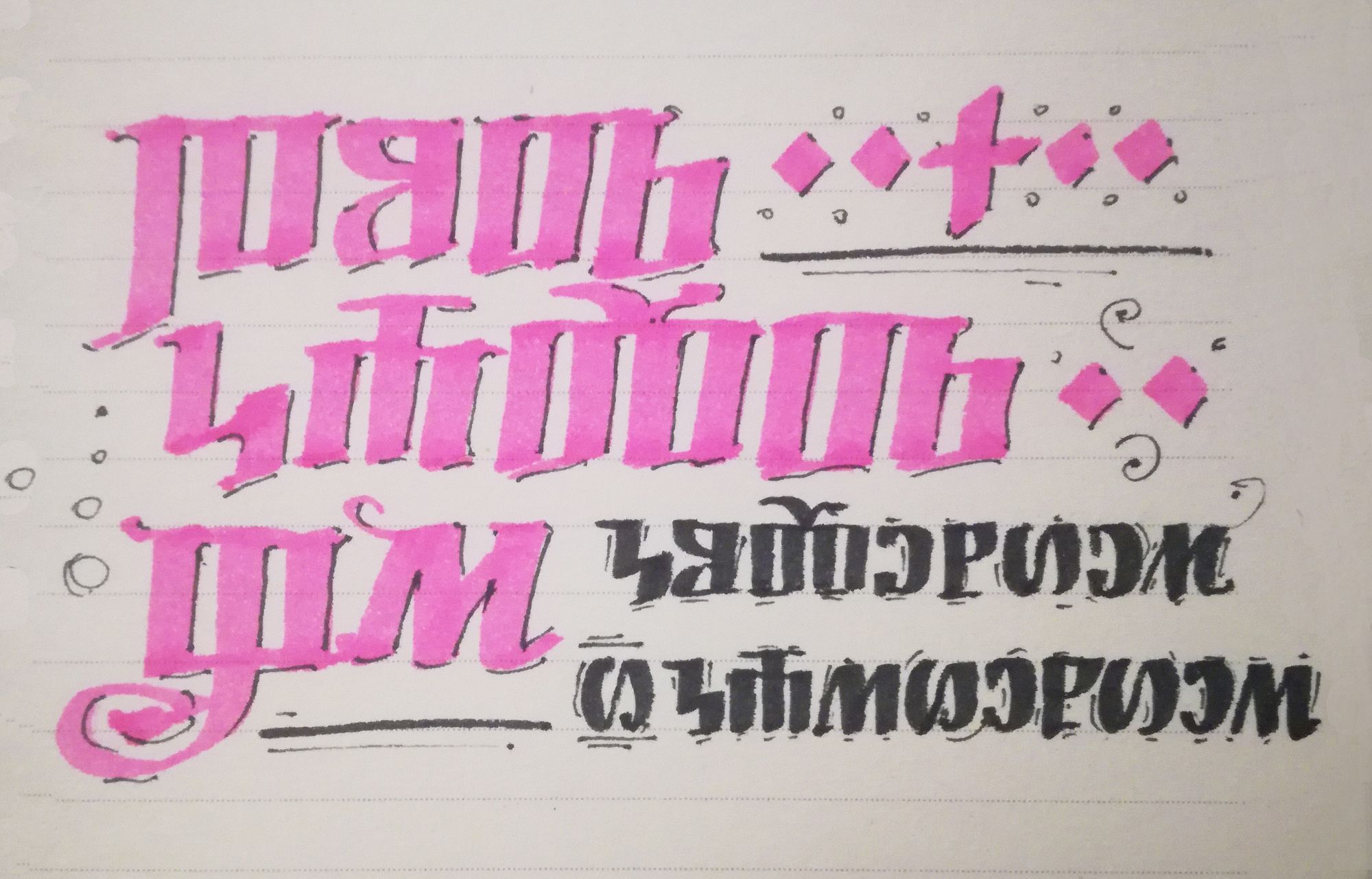
Motivation, and what this project is not
To have this out of the way, my primary motivation is very simple: I love letters. It may be worth to elaborate on that, though.
I am aware of three contexts in which Glagolitsa still remains a topic of discussion, and if you've heard of Glagolitsa before, it was probably in relation to one of them.
First, there is the respectable context of academia. Obviously, Glagolitsa is well known to academics, as well as to some students. Linguists have a good understanding of which sounds glagolitic letters represented, and consequently, how any modern language can be accurately (to the extent possible) transcribed using glagolitic script. Let me be clear: what I'm doing here is more akin to art than it is to science, and my approach is creative rather than descriptive. I'm not a linguist, and while I'm trying to take historical accuracy into account as much as possible, it is not my top priority.
Second, there is a less respectable context of alternative history. Certain people, believing in the glorious Venetic/Wendic Empire, panslavism, or neo-sarmatism, claim that Glagolitsa was in fact an ancient script of pagan Slavic kings, derived from prehistoric Slavic runes, and that the story of Saint Cyril is nothing but Byzantine propaganda. While this Howardesque mythology can be entertaining to some extent, I do not subscribe to it, and sorry, but no panslavic lunatic will have my blessing to use any of my work. In particular, if you are a nationalist and you wish to use my work to further your political agenda, then - as an old Polish proverb says - a dog fucked you, and the entire village fucked you.
Finally, the third context is that of legitimate cultural heritage, as claimed by some people in the Balkans, especially Croatia. There are places in the world where Glagolitsa was in use as recently as two hundred years ago, mostly as a liturgical script. I do not claim such heritage, though.
Thus, as I said before, I have not much in common with either of those groups. Instead, this little project I'm about to present is just a bastard child of my love of lettering, hacking, and tinkering, with no clear practical purpose (unless you're into occultism, in which case the potential benefits should be quite clear already). It doesn't mean, however, that my ideas is entirely random, and what I mean by that, I will explain shortly.

Glagolitsa and Polish language
So, what's the deal with those Slavic things, you may wonder. Is it just an arbitrary label, or does it really mean something? What do Poles, Czechs and Russians have in common? What's the connection between vodka and pickle water? What's the connection between Polish language and Glagolitsa?
Consider a word SZCZOCH, roughly meaning "piss" in Ancient Polish Language. It is a useful word, loved and cherished by good Polish people. While it is a breeze to say it, writing it takes so much effort that it is almost not worth it. I can't help but wonder: what if I could write it not with 7, not even with 4, but with 3 letters? After all, to say the word, I need to produce only 3 to 4 sounds (depending who you ask).

There is a word CHRZĄSZCZ ("a beetle"), featuring not only four phonemes requiring two letters each to be written, but also the infamous Ą - a letter so awkward that even in English it has a Polish name (A-ogonek, meaning "a little tail"), since nobody else cares.
The famously non-existent word DŻDŻ (which would mean "drizzle", if it existed) can - with certain effort - be pronounced using two phonemes. Yet, it is written with four characters, and includes another weird construction: DŻ. As you may know, a pair of consonants put together to represent a single phoneme is called a digraph. We have seven of them in Polish. Two of them are actually useless, since CH is (in modern Polish) pronounced the same as H, and RZ the same as Ż. (Similar issue with letter Ó, pronounced the same as U.)
Is that all? Not quite. Here is a list of all the 14 letters and digraphs in Polish language standing for sounds that cannot be represented by off-the-shelf Latin characters:
Ą, Ę, Ć, Ś, Ń, Ż, Ź, Ł, RZ, SZ, CZ, DZ, DŻ, DŹ
It's almost like Latin alphabet was not meant for Slavic phonetics. Who would've guessed! Do we have a better option, though?
Disclaimer: Cyrillica
Before I say "Glagolitsa", let me address one question that you may already have: why not the Cyrillic alphabet (Cyrillica)? Most of the Slavic countries already use it, and it shouldn't be difficult to adapt it to Polish, too. The answer is: yes, absolutely! I think it is a great idea, which I'm not going to argue against, or compete with. In fact, as you might be aware, there were multiple such attempts already (including at least one by the Russian tzar), and my abovementioned complaints about Polish Latin alphabet are hardly new or original. Let me just say: the idea of Polish Cyrillica has its advantages and disadvantages, and it is a complex problem that I might address in a separate post. For now, I just want to present an alternative.
Well, yes: Glagolitsa.
Being an alphabet created specifically for Slavic phonetics, it requires significantly less gimnastics to fit it to a language like Polish (though it still does need some) - and, in a way, it feels more natural. It doesn't mean, of course, that currently used Polish Latin alphabet is not good enough - despite its shortcomings, Poles are used to it, and have successfully used it for centuries. However, given that Glagolitsa exists, seems to be suitable for Polish language, and, most importantly, it's beautiful and somewhat underappreciated, I wanted to give it a shot. Thus, my primary goal here is to create a Polish version of Glagolitsa that will:
- Take advantage of Glagolitsa's applicability to Slavic phonetics,
- Be practical and easy to learn and use by a modern Polish speaker,
- And finally, that will keep its original character and beauty.
Implementation
To achieve this goal, there are two things we need to deal with. First, visual style. Second, character matching and orthography.

Visual style
This is somewhat arbitrary, and if you actually want to try using Glagolitsa for any practical purpose, I would recommend you to experiment and develop your own style. This was also my approach - I tried writing with different styles for quite a while, until I arrived at something that's more or less consistent and practical. That said, you can certainly use my work as a starting point (that's what this post is about).
If you search for examples of original glagolitic writings, you will find that many very different writing styles developed over the ages, some of them seemingly having little in common with each other. There are two major versions of Glagolitsa: round (obla, aka Bulgarian), and angular (uglata, aka Croatian). Round version is the original one, while the angular version developed later, and was in use for much longer. Both were used for engravings and manuscripts. On top of that, a variety of cursive styles were used for things like documents, letters, etc.
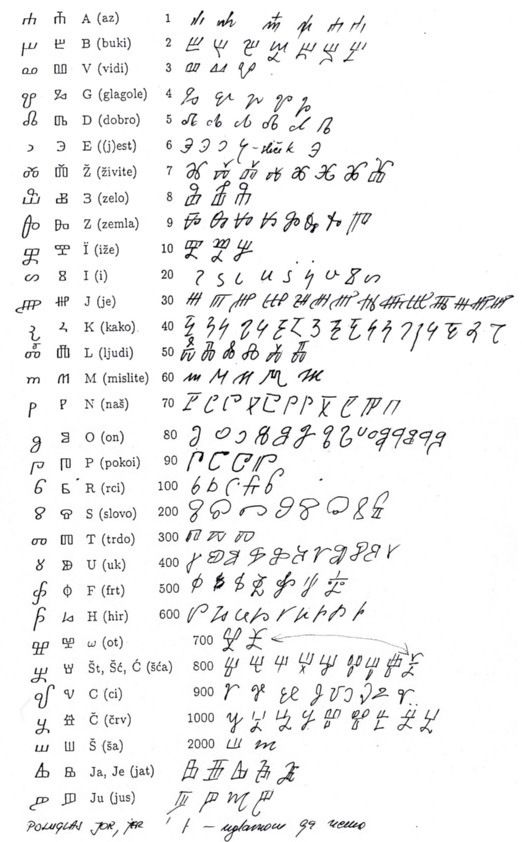
Arguably, even though it's a pleasure to do glagolitic calligraphy with proper writing tools, it is quite difficult to make obla or uglata Glagolitsa look good with standard modern pen and paper. I therefore decided to try and develop my own style, attempting to strike a balance between the authentic feel and practical usability. I took the uglata style as a basis, since I generally like it more - it seems more mature and consistent, less "pictographic" and more modular. Nevertheless, I mostly abandoned the angular eye-candy look, as it is difficult to write with a ball pen. I practiced several versions of cursive, based on the samples I could find, and drew heavy influence from some of them. I didn't want to introduce too much complexity, though, and in most cases decided to keep lower case letters very close to their upper case counterparts. This will make it easier to read and write.
In the pictures above and below, you can see a few samples of my glagolitic handwriting, using different styles. I think the cursive version lacks some smoothness, and I will definitely put more work into it. On the other hand, the letters are quite easily recognizable compared to e.g. Cyrillic cursive, where consecutive characters can very easily blend into each other, making it a nightmare to read for non-natives. This is one clear advantage.
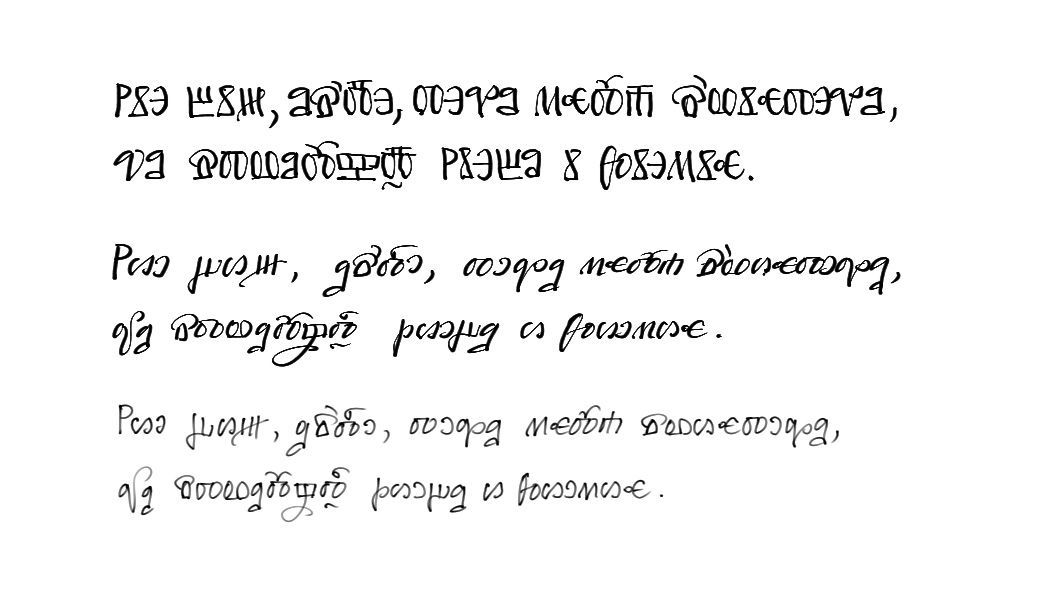
One very characteristic thing about Croatian Glagolitsa is its heavy use of ligatures, possibly featuring the largest number of ligatures of all the writing systems ever invented. While I love ligatures with all my heart (in fact, they are the reason why I looked into Glagolitsa in the first place!), I decided to ignore them for now. Even though the use of ligatures could theoretically make writing faster and more concise, it would also make the learning curve much steeper. I'm sure I will return to them at some point, though.
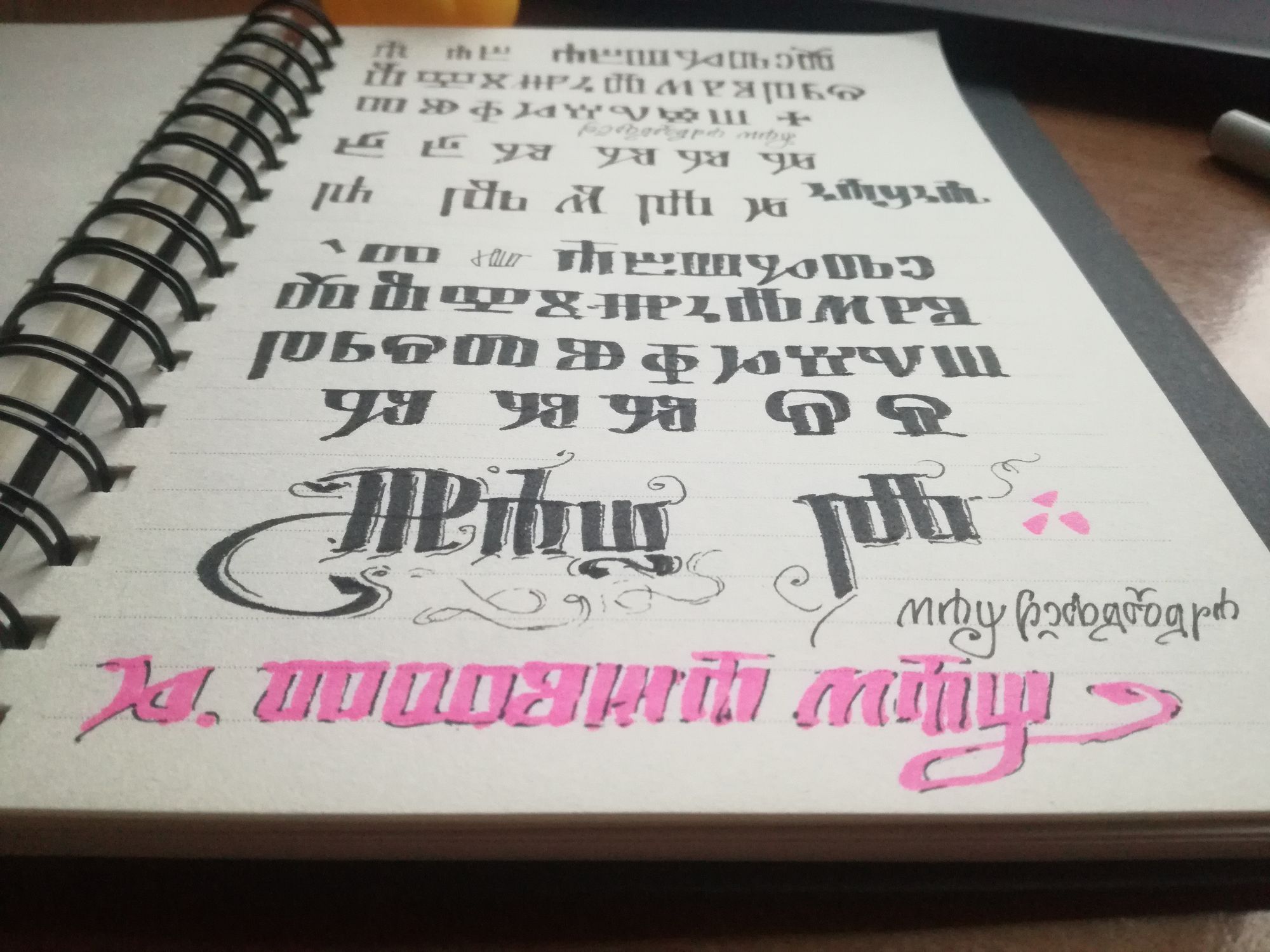
Orthography
I ranted furiously about all the diacritics and digraphs, and how Glagolitsa can solve this issue, so now I should be able to deliver on my promises. Spoiler: I won't be able to do it completely. Still, we can significantly reduce the number of those ad hoc weirdos, as well as reduce the length of an average Polish word, as it is written, by quite a lot.
Whatever path we take, there will be a bunch of more or less arbitrary decisions to be made. Dear linguists out there, don't flagellate me! Some of my decisions might seem outrageous, but keep in mind I do it pro publico bono.
As I mentioned before, Glagolitsa was never applied to modern Polish. It was briefly used in Poland in XIV/XVc., but as far as I know, no examples from this time survived. Even if they had, Polish phonetics changed quite a bit since medieval times, so it probably wouldn't help us much. There's no need to worry though, as the phonetic values of glagolitic letters are well known, and we can easily take it from there.
Let me start with the "basic" alphabet, which should be mostly uncontroversial:
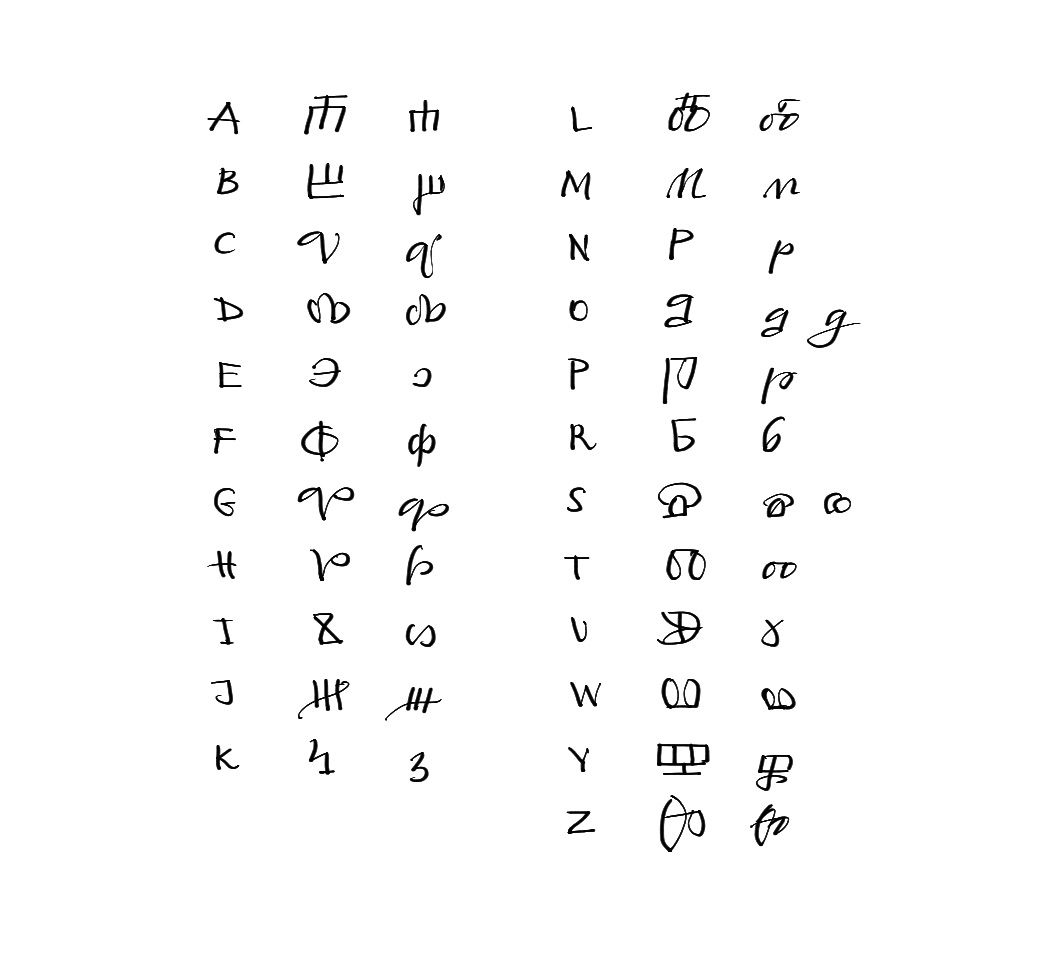
There's not much to discuss here, except perhaps J and Y. The glagolitic letters I assigned to them are called je and iže, respectively. Originally, iže represented a long "i" (/j/). However, I also needed a letter for Y (/ɘ̟/). There is a way to represent this sound in "standard" Glagolitsa, but it requires more than one character, and this I wanted to avoid, especially as Y is quite common in Polish language. Because of that, I decided to assign iže to Y, and je to J.
Now, the most tricky part are all the "hissing" and "soft" consonants. Glagolitsa has exact or close matches for most of them, but there are a few which are not obvious. Since Glagolitsa evolved a lot (together with languages it was used with), and the same characters could have had slightly different phonetic values in different contexts, I decided not to worry too much about "historical accuracy", and just go on with some sensible and practical choices. In particular, I wanted to avoid using jers - special characters which are used in glagolitic (and also Cyrillic) script to control the "softness" of letters that precede them (it's a bit more complicated than that, but I don't want to go into details, especially as I'm not a linguist). For example, in Cyrillic, Polish letter Ń (/ɲ/, soft "n") could be transcribed as нь, where н represents "n", and ь is a "soft sign". Those jers add extra length to written words, and are also unintuitive for Polish speakers, as Polish writing system never used them. There are appropriate characters in Glagolitsa to represent jers, but I would rather not use them, because of the reasons mentioned. What I will do instead, is use an apostrophe to mark letters that should be softened. This will apply to Ń, Ś, Ź, and DŹ, and I think it should be very intuitive to a Polish speaker. The only exception from this rule is Ć, which has its own separate letter in Glagolitsa, and I didn't want to waste a good letter just for the sake of consistency.
Next thing to consider are all the digraphs. RZ (=Ż, /ʐ/), DZ (/d͡z/), CZ (/t͡ʂ/), and SZ (/ʂ/) seem to have their close counterparts in original Glagolitsa. I wasn't quite sure about DŻ (/d͡ʐ/), but I decided to use the glagolitic letter djervь (which might, in fact, be closer to Polish DŹ, but I hope it's a minor sin).
Polish letter Ł (/w/) doesn't seem to have its direct counterpart in Glagolitsa, and it was a bit of a confusing problem to solve. In Russian, for that matter, a sound similar to Polish "ł" is written as л, while the (closest) counterpart of Polish "l" - ль. If L is the "soft" version, then it would be wrong to try to represent Ł as L' (which might initially seem like a tempting idea). On the other hand, representing L as Ł' is a nasty solution, since it's a lot of extra writing (L is much more common than Ł in Polish). Finally, I decided to give the glagolitic ljudьje a little "wave" to turn the sound from "l" to "ł". Maybe I will come up with a better solution at some point.
Ą (/ɔ̃/) and Ę (/ɛ̃/), the most Polish letters out there, (perhaps surprisingly) do have their direct counterparts in Glagolitsa - which makes it, in this aspect, the best writing system for Polish language, as even Cyrillica doesn't have those two (though, to be fair, it used to have them in its medieval version!).
I decided to ignore the ortographic alternatives (RZ=Ż, U=Ó, CH=H), as their only purpose in modern Polish is to torture dyslexic students.
Finally, I decided to keep vowel pairs "ia", "ie", "iu" written with two characters, as it is in Polish Latin (and unlike in e.g. Russian/Ukrainian), even though there are glagolitic characters available for those pairs. I thought it would be confusing for Polish speakers to introduce this convention. I must admit, this is the decision I am least certain about.
That's it! You can see the results below.
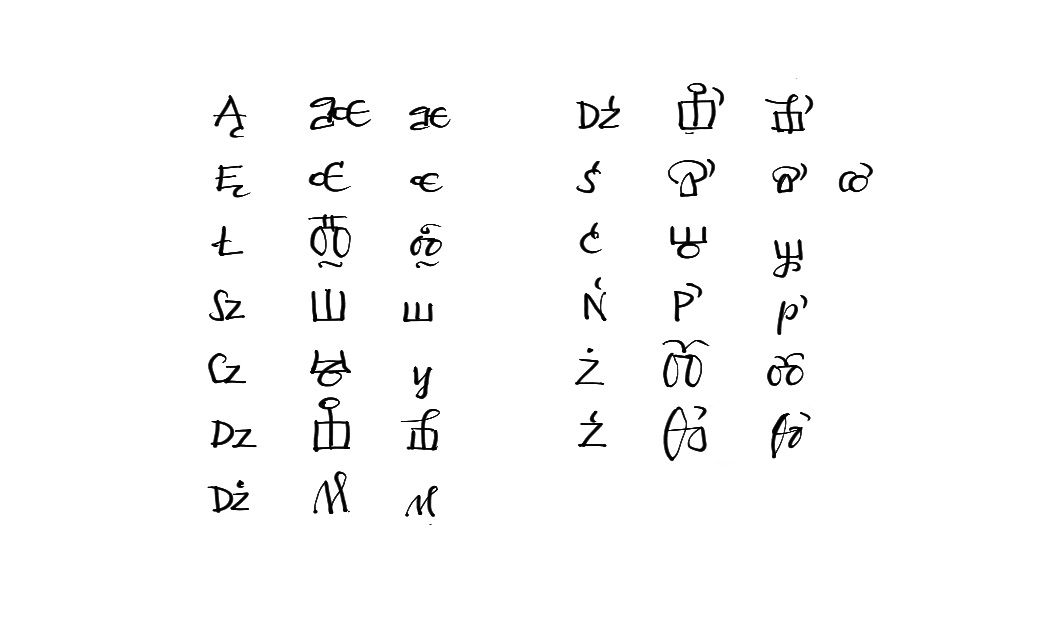
I tried my best to make use of the available glagolitic letters - even if it meant repurposing them a bit - instead of inventing weird variants or using digraphs. I also managed to avoid introducing any foreign or entirely made-up letters. As a side effect, that means that all of my examples from this post can be typeset using any of the available digital glagolitic fonts. Some of them you can download here (also for LaTeX!): http://croatianhistory.net/etf/gl-font.html or here: http://synaxis.info/azbuka/4_fonts/01_ustav.html.
Conclusions
Having all of those letters in our toolbelt, we can now write any Polish text we want. I found that with a little practice, using this script for notetaking or journaling doesn't require much effort. Additionally - even though I was not very conservative with my choices - I think a Polish-speaking linguist, who knows Glagolitsa from studying Old Church Slavonic, would be able to read my examples.
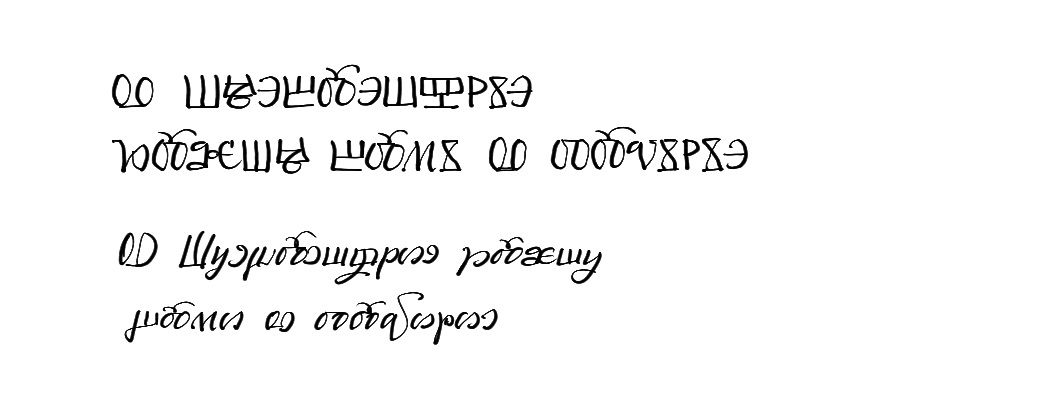
If you're a linguist and you think I messed up something badly, I welcome any feedback, criticism, and suggestions! (You can find my email on the "About" page.) This is still a work in progress, and as I read more about Glagolitsa, perhaps I will have to rethink some of my choices.
Below you can find a few more samples (along with Polish Latin versions), to give you a better feeling of how it may look in practice.
